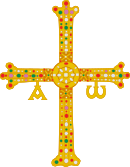San Julián De Los Prados
The church's construction was ordered by Alfonso II of Asturias and it was built by the court architect Tioda c. 830. It is dedicated to the martyred Egyptian saints Julian and Basilissa.
Architecture
The spacious church clearly displays the characteristics of its style. It is of basilican plan with a nave and two aisles separated by square piers which support semi-circular arches and with a transept of impressive height. The iconostasis, that separates the sanctuary from the rest of the church is remarkably similar in appearance to a triumphal arch. The size and originality of the church stands out and distinguishes it from works of Visigothic art. However, without doubt, that which most attracts attention to this church is the pictorial decoration, with aniconic frescoes (stucco, very well executed), painted in three layers, with architectural decoration that bears clear Roman influences. Although it appears more a monastic rather than a royal church, a gallery was reserved for the king in the transept.

Of the three original entrances to the church, two have been filled in.
Decoration
Sculptural
The only sculptural decoration that has survived to the present day is that of the marble capitals on which rest the semi-circular arches. There are also two marble flagstones with hexagonal geometric figures and floral motives that are found in the central chapel.
Pictorial
The pictorial decoration is the most important element that can be seen in the church. It is without doubt the most important of its time, in its extent and conservation as much as in the variety of designs represented, in all of Western Europe.
See also
Notes
- ^ Moffitt, John Francis (1999). The Arts in Spain. London: Thames and Hudson. ISBN 978-0-500-20315-6.
- ^ It can only be compared in extent with the church of St. John of Müstair, a Carolingian church in Graubünden, Switzerland, whose frescoes date from c.800AD. In Germany, on Reichenau Island, is found the church of St. George of Oberzell. In this church the frescoes are also of a similar extent but they date from the tenth century
- ^ García de Castro Valdés, César (2004). Santa María de Arzabal. Oviedo: Ediciones Nobel. ISBN 978-84-8459-181-8.
{{cite book}}:|work=ignored (help)
References
- Arias Páramo, Lorenzo (1997). San Julián de los Prados. Arte prerrománico asturiano (in Spanish). Gijón: Trea Ediciones. ISBN 978-84-89427-74-7.
- Arias Páramo, Lorenzo (1991). Iglesia de San Julián de los Prados. Dibujos Planimétricos. Fundación Museo Evaristo Valle. ISBN 978-84-604-0881-9.
- Moffitt, John F. (1999). The arts in Spain (in Spanish). London: Thames and Hudson. ISBN 978-0-500-20315-6.
- de Selgas, Fortunato (1908). Monumentos ovetenses del siglo IX (in Spanish). Nueva Impr. de San Francisco de Sales. Archived from the original on 6 November 2012.
Gallery
-
Exterior of the church
-
Entrance
-
Interior
-
Interior with mural paintings
-
Interior with mural paintings







